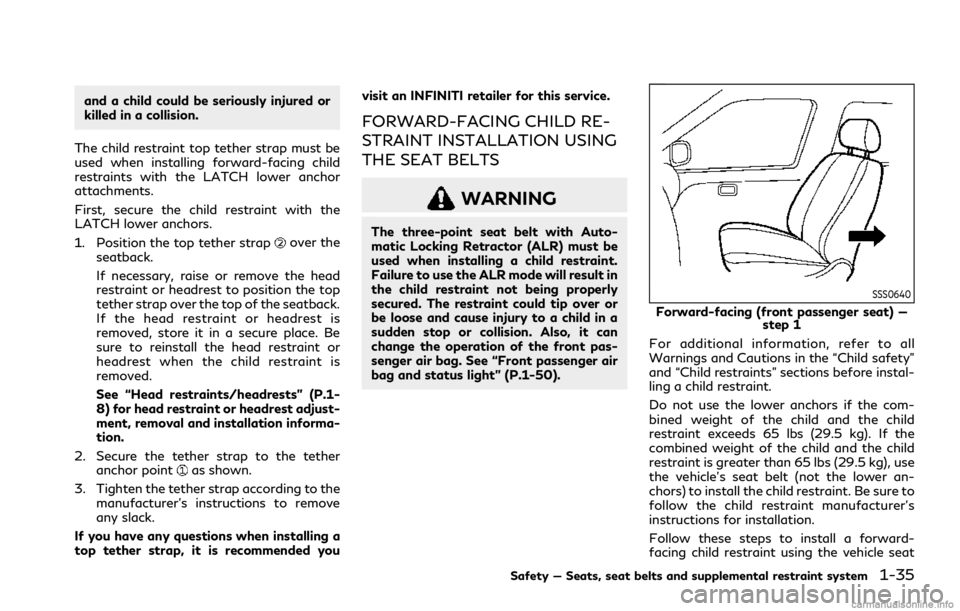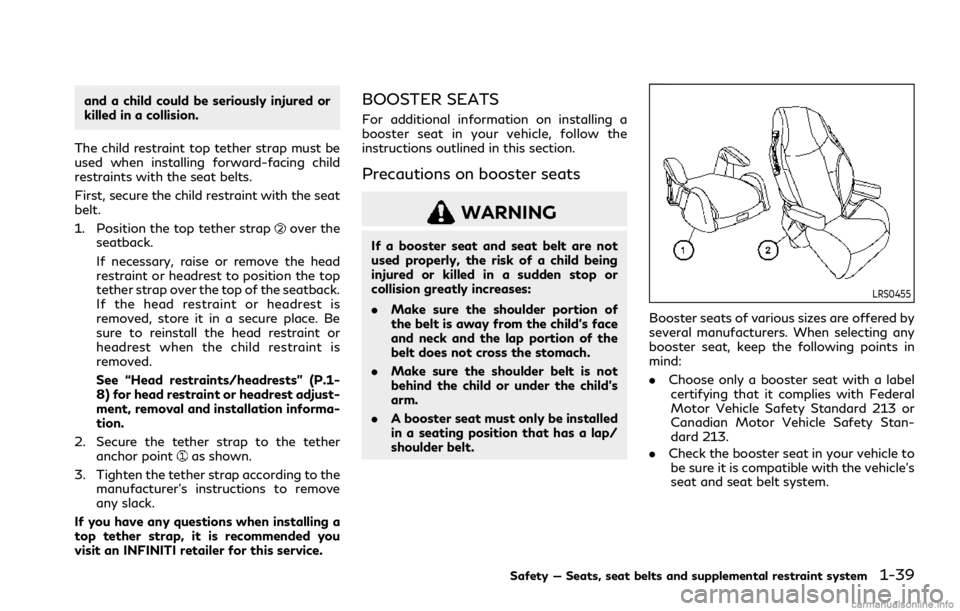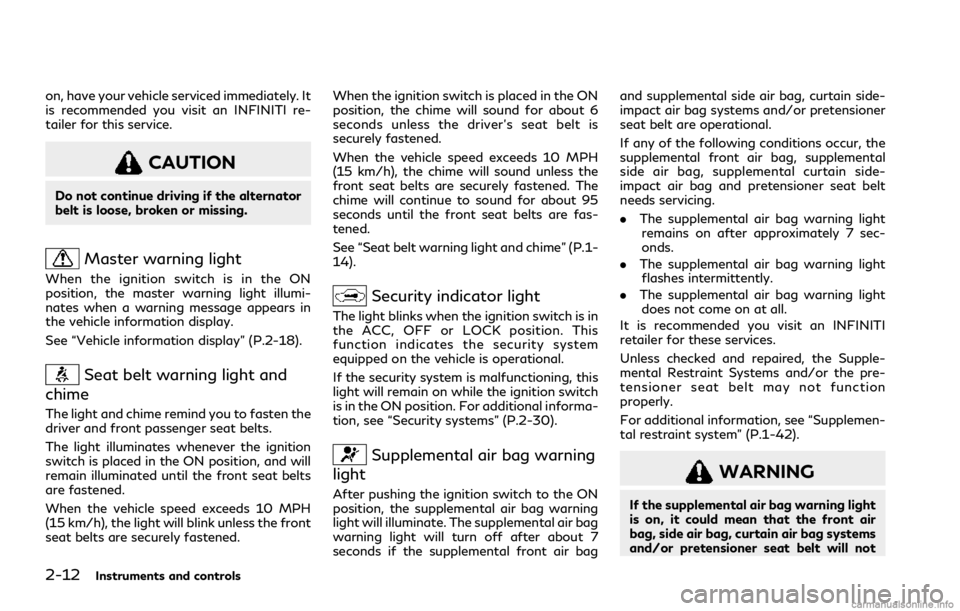ECU INFINITI Q50 2021 Owner's Guide
[x] Cancel search | Manufacturer: INFINITI, Model Year: 2021, Model line: Q50, Model: INFINITI Q50 2021Pages: 484, PDF Size: 1.86 MB
Page 55 of 484

and a child could be seriously injured or
killed in a collision.
The child restraint top tether strap must be
used when installing forward-facing child
restraints with the LATCH lower anchor
attachments.
First, secure the child restraint with the
LATCH lower anchors.
1. Position the top tether strap
over the
seatback.
If necessary, raise or remove the head
restraint or headrest to position the top
tether strap over the top of the seatback.
If the head restraint or headrest is
removed, store it in a secure place. Be
sure to reinstall the head restraint or
headrest when the child restraint is
removed.
See “Head restraints/headrests” (P.1-
8) for head restraint or headrest adjust-
ment, removal and installation informa-
tion.
2. Secure the tether strap to the tether anchor point
as shown.
3. Tighten the tether strap according to the manufacturer’s instructions to remove
any slack.
If you have any questions when installing a
top tether strap, it is recommended you visit an INFINITI retailer for this service.
FORWARD-FACING CHILD RE-
STRAINT INSTALLATION USING
THE SEAT BELTS
WARNING
The three-point seat belt with Auto-
matic Locking Retractor (ALR) must be
used when installing a child restraint.
Failure to use the ALR mode will result in
the child restraint not being properly
secured. The restraint could tip over or
be loose and cause injury to a child in a
sudden stop or collision. Also, it can
change the operation of the front pas-
senger air bag. See “Front passenger air
bag and status light” (P.1-50).
SSS0640
Forward-facing (front passenger seat) —
step 1
For additional information, refer to all
Warnings and Cautions in the “Child safety”
and “Child restraints” sections before instal-
ling a child restraint.
Do not use the lower anchors if the com-
bined weight of the child and the child
restraint exceeds 65 lbs (29.5 kg). If the
combined weight of the child and the child
restraint is greater than 65 lbs (29.5 kg), use
the vehicle’s seat belt (not the lower an-
chors) to install the child restraint. Be sure to
follow the child restraint manufacturer’s
instructions for installation.
Follow these steps to install a forward-
facing child restraint using the vehicle seat
Safety — Seats, seat belts and supplemental restraint system1-35
Page 56 of 484

1-36Safety — Seats, seat belts and supplemental restraint system
belt in the rear seats or in the front
passenger seat:
1.If you must install a child restraint in the
front seat, it should be placed in a
forward-facing direction only. Move
the seat to the rearmost position. Child
restraints for infants must be used in the
rear-facing direction and, therefore,
must not be used in the front seat.
2. Position the child restraint on the seat. Always follow the child restraint manu-
facturer’s instructions.
The back of the child restraint should be
secured against the vehicle seatback.
If necessary, adjust or remove the head
restraint or headrest to obtain the
correct child restraint fit. If the head
restraint or headrest is removed, store it
in a secure place. Be sure to reinstall the
head restraint or headrest when the
child restraint is removed. See “Head
restraints/headrests” (P.1-8) for head
restraint or headrest adjustment, re-
moval and installation information.
If the seating position does not have an
adjustable head restraint or headrest
and it is interfering with the proper child
restraint fit, try another seating position
or a different child restraint.
SSS0360B
Forward-facing — step 3
3. Route the seat belt tongue through the child restraint and insert it into the buckle
until you hear and feel the latch engage.
Be sure to follow the child restraint
manufacturer’s instructions for belt
routing.
If the child restraint is equipped with a
top tether strap, route the top tether
strap and secure the tether strap to the
tether anchor point (rear seat installation
only). See “Installing top tether strap”
(P.1-38). Do not install child restraints
that require the use of a top tether strap
in seating positions that do not have a
top tether anchor.
SSS0651
Forward-facing — step 4
4. Pull the shoulder belt until the belt is fully extended. At this time, the seat belt
retractor is in the Automatic Locking
Retractor (ALR) mode (child restraint
mode). It reverts to Emergency Locking
Retractor (ELR) mode when the seat belt
is fully retracted.
Page 57 of 484

SSS0652
Forward-facing — step 5
5. Allow the seat belt to retract. Pull up on the shoulder belt to remove any slack in
the belt.
SSS0653
Forward-facing — step 6
6. Remove any additional slack from the seat belt; press downward and rearward
firmly in the center of the child restraint
with your knee to compress the vehicle
seat cushion and seatback while pulling
up on the seat belt.
7. Tighten the tether strap according to the manufacturer’s instructions to remove
any slack.
SSS0641
Forward-facing — step 8
8. After attaching the child restraint, test it before you place the child in it. Push it
from side to side while holding the child
restraint near the seat belt path. The
child restraint should not move more
than 1 inch (25 mm), from side to side.
Try to tug it forward and check to see if
the belt holds the restraint in place. If the
restraint is not secure, tighten the seat
belt as necessary, or put the restraint in
another seat and test it again. You may
need to try a different child restraint. Not
all child restraints fit in all types of
vehicles.
9. Check to make sure the child restraint is properly secured prior to each use. If the
Safety — Seats, seat belts and supplemental restraint system1-37
Page 59 of 484

and a child could be seriously injured or
killed in a collision.
The child restraint top tether strap must be
used when installing forward-facing child
restraints with the seat belts.
First, secure the child restraint with the seat
belt.
1. Position the top tether strap
over the
seatback.
If necessary, raise or remove the head
restraint or headrest to position the top
tether strap over the top of the seatback.
If the head restraint or headrest is
removed, store it in a secure place. Be
sure to reinstall the head restraint or
headrest when the child restraint is
removed.
See “Head restraints/headrests” (P.1-
8) for head restraint or headrest adjust-
ment, removal and installation informa-
tion.
2. Secure the tether strap to the tether anchor point
as shown.
3. Tighten the tether strap according to the manufacturer’s instructions to remove
any slack.
If you have any questions when installing a
top tether strap, it is recommended you
visit an INFINITI retailer for this service.
BOOSTER SEATS
For additional information on installing a
booster seat in your vehicle, follow the
instructions outlined in this section.
Precautions on booster seats
WARNING
If a booster seat and seat belt are not
used properly, the risk of a child being
injured or killed in a sudden stop or
collision greatly increases:
. Make sure the shoulder portion of
the belt is away from the child’s face
and neck and the lap portion of the
belt does not cross the stomach.
. Make sure the shoulder belt is not
behind the child or under the child’s
arm.
. A booster seat must only be installed
in a seating position that has a lap/
shoulder belt.
LRS0455
Booster seats of various sizes are offered by
several manufacturers. When selecting any
booster seat, keep the following points in
mind:
.Choose only a booster seat with a label
certifying that it complies with Federal
Motor Vehicle Safety Standard 213 or
Canadian Motor Vehicle Safety Stan-
dard 213.
. Check the booster seat in your vehicle to
be sure it is compatible with the vehicle’s
seat and seat belt system.
Safety — Seats, seat belts and supplemental restraint system1-39
Page 61 of 484

SSS0640
1.If you must install a booster seat in the
front seat, move the seat to the rear-
most position.
2. Position the booster seat on the seat. Only place it in a forward-facing direc-
tion. Always follow the booster seat
manufacturer’s instructions.
LRS0454
Front passenger position
3. The booster seat should be positioned on the vehicle seat so that it is stable.
If necessary, adjust or remove the head
restraint or headrest to obtain the
correct booster seat fit. If the head
restraint or headrest is removed, store
it in a secure place. Be sure to reinstall
the head restraint or headrest when the
booster seat is removed. See “Head
restraints/headrests” (P.1-8) for head
restraint or headrest adjustment, re-
moval and installation information.
If the seating position does not have an
adjustable head restraint or headrest
and it is interfering with the proper booster seat fit, try another seating
position or a different booster seat.
4. Position the lap portion of the seat belt low and snug on the child’s hips. Be sure
to follow the booster seat manufac-
turer’s instructions for adjusting the seat
belt routing.
5. Pull the shoulder belt portion of the seat belt toward the retractor to take up
extra slack. Be sure the shoulder belt is
positioned across the top, middle portion
of the child’s shoulder. Be sure to follow
the booster seat manufacturer’s instruc-
tions for adjusting the seat belt routing.
6. Follow the warnings, cautions and in- structions for properly fastening a seat
belt shown in “Seat belts” (P.1-12).
Safety — Seats, seat belts and supplemental restraint system1-41
Page 73 of 484

In addition to the above, certain objects
placed on the front passenger seat may also
cause the light to operate as described
above depending on their weight.
For additional information related to the
normal operation and troubleshooting of
this occupant classification sensor system,
please refer to “Normal operation” (P.1-54)
and “Troubleshooting” (P.1-55).
Front passenger air bag:
The front passenger air bag is designed to
automatically turn OFF when the vehicle is
operated under some conditions as de-
scribed below in accordance with U.S.
regulations. If the front passenger air bag
is OFF, it will not inflate in a crash. The driver
air bag and other air bags in your vehicle are
not part of this system.
The purpose of the regulation is to help
reduce the risk of injury or death from an
inflating air bag to certain front passenger
seat occupants, such as children, by requiring
the air bag to be automatically turned OFF.
Certain sensors are used to meet the
requirements.
The occupant classification sensor in this
vehicle is a weight sensor. It is designed to
detect an occupant and objects on the seat
by weight. For example, if a child is in the
front passenger seat, the Advanced Air Bag
System is designed to turn the passenger airbag OFF in accordance with the regulations.
Also, if a child restraint of the type specified
in the regulations is on the seat, its weight
and the child’s weight can be detected and
cause the air bag to turn OFF.
Front passenger seat adult occupants who
are properly seated and using the seat belt
as outlined in this manual should not cause
the passenger air bag to be automatically
turned OFF. For small adults it may be
turned OFF, however, if the occupant takes
his/her weight off the seat cushion (for
example, by not sitting upright, by sitting on
an edge of the seat, or by otherwise being
out of position), this could cause the sensor
to turn the air bag OFF. Always be sure to be
seated and wearing the seat belt properly
for the most effective protection by the seat
belt and supplemental air bag.
INFINITI recommends that pre-teens and
children be properly restrained in a rear seat.
INFINITI also recommends that appropriate
child restraints and booster seats be prop-
erly installed in a rear seat. If this is not
possible, the occupant classification sensor
is designed to operate as described above to
turn the front passenger air bag OFF for
specified child restraints as required by the
regulations. Failing to properly secure child
restraints and to use the ALR mode may
allow the restraint to tip or move in a
collision or sudden stop. This can also result
in the passenger air bag inflating in a crash
instead of being OFF. For additional infor-
mation, refer to “Child restraints” (P.1-22)
for proper use and installation.
If the front passenger seat is not occupied,
the passenger air bag is designed not to
inflate in a crash. However, heavy objects
placed on the seat could result in air bag
inflation, because of the object’s weight
detected by the occupant classification
sensor. Other conditions could also result in
air bag inflation, such as if a child is standing
on the seat, or if two children are on the
seat, contrary to the instructions in this
manual. Always be sure that you and all
vehicle occupants are seated and restrained
properly.
Using the front passenger air bag status
light, you can monitor when the front
passenger air bag is automatically turned
OFF.
If an adult occupant is in the seat but the
front passenger air bag status light is
illuminated (indicating that the air bag is
OFF), it could be that the person is a small
adult, or is not sitting on the seat properly or
not using the seat belt properly.
If a child restraint must be used in the front
seat, the front passenger air bag status light
may or may not be illuminated, depending on
the size of the child and the type of child
Safety — Seats, seat belts and supplemental restraint system1-53
Page 83 of 484

2 Instruments and controls
Cockpit ........................................................................\
......... 2-3
Instrument panel ............................................................... 2-5
Meters and gauges .......................................................... 2-6Speedometer and odometer ..................................... 2-7
Tachometer ................................................................... 2-8
Engine coolant temperature gauge ....................... 2-8
Fuel gauge ..................................................................... 2-9
Warning lights, indicator lights and audible
reminders ........................................................................\
... 2-10 Checking lights ........................................................... 2-11
Warning/indicator lights (red) ............................... 2-11
Warning/indicator lights (yellow) ......................... 2-13
Warning/indicator lights (other) ........................... 2-17
Audible reminders ..................................................... 2-17
Vehicle information display .......................................... 2-18 Indicators for operation .......................................... 2-21
Indicators for maintenance .................................... 2-24
Trip computer ............................................................. 2-27
Clock and outside air temperature ....................... 2-29
Security systems ............................................................ 2-30
Vehicle Security System ......................................... 2-30
INFINITI Vehicle Immobilizer System .................. 2-31
Wiper and washer switch ............................................. 2-32
Rain-sensing auto wiper system ........................... 2-34 Rear window and outside mirror
defroster switch ............................................................. 2-35
Headlight and turn signal switch ............................... 2-35
Headlight switch ..................................................... 2-35
Turn signal switch ................................................... 2-41
Fog light switch ....................................................... 2-42
Horn ........................................................................\
........... 2-42
Vehicle Dynamic Control (VDC) OFF switch ......... 2-42
Heated seats (if so equipped) ..................................... 2-43 Operation with switch .......................................... 2-44
Operation with touch screen .............................. 2-44
AUTO mode setting .............................................. 2-44
Heated steering wheel (if so equipped) .................. 2-44
Power outlets .................................................................. 2-45
Emergency Call (SOS) button (if so equipped) ...... 2-46 Emergency support ................................................ 2-46
Storage ........................................................................\
.... 2-48 Cup holders .............................................................. 2-48
Soft bottle holder .................................................... 2-49
Sunglasses holder .................................................... 2-49
Glove box .................................................................. 2-50
Console box ............................................................. 2-50
Card holder .............................................................. 2-50
Storage box .............................................................. 2-51
Page 92 of 484

2-10Instruments and controls
Warning/indicator lights (red)Warning/indicator lights (yellow) Warning/indicator lights (other)
Brake warning lightAnti-lock Braking System (ABS) warning
lightECO drive indicator light
Charge warning lightForward Emergency Braking (FEB) sys-
tem warning lightExterior light indicator
Master warning lightFront passenger air bag status lightFront fog light indicator light
Seat belt warning light and chimeLow fuel warning lightHigh beam assist indicator light (if so
equipped)
Security indicator lightLow tire pressure warning lightHigh beam indicator light
Supplemental air bag warning lightMalfunction Indicator Light (MIL)Turn signal/hazard indicator lights
Master warning light
Power steering warning light
Vehicle Dynamic Control (VDC) off in-
dicator light
Vehicle Dynamic Control (VDC) warning
light
WARNING LIGHTS, INDICATOR
LIGHTS AND AUDIBLE REMINDERS
Page 94 of 484

2-12Instruments and controls
on, have your vehicle serviced immediately. It
is recommended you visit an INFINITI re-
tailer for this service.
CAUTION
Do not continue driving if the alternator
belt is loose, broken or missing.
Master warning light
When the ignition switch is in the ON
position, the master warning light illumi-
nates when a warning message appears in
the vehicle information display.
See “Vehicle information display” (P.2-18).
Seat belt warning light and
chime
The light and chime remind you to fasten the
driver and front passenger seat belts.
The light illuminates whenever the ignition
switch is placed in the ON position, and will
remain illuminated until the front seat belts
are fastened.
When the vehicle speed exceeds 10 MPH
(15 km/h), the light will blink unless the front
seat belts are securely fastened. When the ignition switch is placed in the ON
position, the chime will sound for about 6
seconds unless the driver’s seat belt is
securely fastened.
When the vehicle speed exceeds 10 MPH
(15 km/h), the chime will sound unless the
front seat belts are securely fastened. The
chime will continue to sound for about 95
seconds until the front seat belts are fas-
tened.
See “Seat belt warning light and chime” (P.1-
14).
Security indicator light
The light blinks when the ignition switch is in
the ACC, OFF or LOCK position. This
function indicates the security system
equipped on the vehicle is operational.
If the security system is malfunctioning, this
light will remain on while the ignition switch
is in the ON position. For additional informa-
tion, see “Security systems” (P.2-30).
Supplemental air bag warning
light
After pushing the ignition switch to the ON
position, the supplemental air bag warning
light will illuminate. The supplemental air bag
warning light will turn off after about 7
seconds if the supplemental front air bag and supplemental side air bag, curtain side-
impact air bag systems and/or pretensioner
seat belt are operational.
If any of the following conditions occur, the
supplemental front air bag, supplemental
side air bag, supplemental curtain side-
impact air bag and pretensioner seat belt
needs servicing.
.
The supplemental air bag warning light
remains on after approximately 7 sec-
onds.
. The supplemental air bag warning light
flashes intermittently.
. The supplemental air bag warning light
does not come on at all.
It is recommended you visit an INFINITI
retailer for these services.
Unless checked and repaired, the Supple-
mental Restraint Systems and/or the pre-
tensioner seat belt may not function
properly.
For additional information, see “Supplemen-
tal restraint system” (P.1-42).
WARNING
If the supplemental air bag warning light
is on, it could mean that the front air
bag, side air bag, curtain air bag systems
and/or pretensioner seat belt will not
Page 104 of 484

2-22Instruments and controls
reaches the empty (0) position.
There is a small reserve of fuel remaining in
the tank when the fuel gauge reaches the
empty (0) position.
11. Low washer fluid warning
This warning appears when the washer tank
fluid is at a low level. Add washer fluid as
necessary. (See “Window washer fluid” (P.8-
10).)
12. Door/trunk open warning
This warning appears if any of the doors
and/or the trunk lid are open or not closed
securely. The vehicle icon indicates which
door or the trunk lid is open on the display.
13. Intelligent Key system warning
This warning appears if there is a malfunc-
tion in the Intelligent Key system.
If this warning appears while the engine is
stopped, the engine cannot be started. If this
warning appears while the engine is running,
the vehicle can be driven. However, in these
cases, have the system checked as soon as
possible. It is recommended you visit an
INFINITI retailer for this service.
14. Loose Fuel Cap warning
This warning appears when the fuel-filler
cap is not tightened correctly after thevehicle has been refueled. (See “Fuel-filler
cap” (P.3-25).)
15. Tire Pressure Low - Add Air
warning
This warning appears when the low tire
pressure warning light in the meter illumi-
nates and low tire pressure is detected. The
warning appears each time the ignition
switch is placed in the ON position as long
as the low tire pressure warning light
remains illuminated. If this warning appears,
stop the vehicle and adjust the pressure to
the recommended COLD tire pressure
shown on the Tire and Loading Information
label. (See “Low tire pressure warning light”
(P.2-13) and “Tire Pressure Monitoring
System (TPMS)” (P.5-5).)
16. Flat Tire - Visit dealer warning
(if so equipped)
This warning appears when the low tire
pressure warning light in the meter illumi-
nates and one or more flat tires are detected
while driving. A chime also sounds for
approximately 10 seconds. (See “Low tire
pressure warning light” (P.2-13) and “Tire
Pressure Monitoring System (TPMS)” (P.5-
5).)
17. Low oil pressure warning
This warning appears if low engine oil
pressure is detected. If the warning appears
during normal driving, pull off the road in a
safe area, stop the engine immediately and
call an INFINITI retailer or other authorized
repair shop.
The low oil pressure warning is not designed
to indicate a low oil level. Use the dipstick to
check the oil level. (See “Engine oil” (P.8-7).)
18. All-Wheel Drive (AWD) warning
(if so equipped)
This warning appears when the Intelligent
All-Wheel Drive (AWD) system is not func-
tioning properly while the engine is running.
The displayed message will vary depending
on the condition of the AWD system mal-
function. (See “Intelligent All-Wheel Drive
(AWD)” (P.5-120).)
19. Extended storage fuse warning
(if so equipped)
This warning may appear if the extended
storage fuse switch is not pushed in
(switched on). When this warning appears,
push in (switch on) the extended storage
fuse switch to turn off the warning. For
more information, see “Extended storage
fuse switch” (P.8-19).